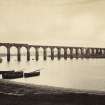Royal Border Bridge
Railway Bridge (19th Century) - (20th Century)
Site Name Royal Border Bridge
Classification Railway Bridge (19th Century) - (20th Century)
Alternative Name(s) River Tweed; Berwick-upon-tweed; Spittal
Canmore ID 292953
Site Number NT95SE 84
NGR NT 99266 53245
Datum OSGB36 - NGR
Permalink http://canmore.org.uk/site/292953
- Council Northumberland
- Parish Berwick-upon-tweed
- Former Region Northumberland
- Former District Berwick-upon-tweed
- Former County Northumberland
Construction (1847 - 1850)
Project (2007)
This project was undertaken to input site information listed in 'Civil engineering heritage: Scotland - Lowlands and Borders' by R Paxton and J Shipway, 2007.
Publication Account (2007)
Together with the crossing of the Tyne at Newcastle, the Royal Border Bridge over the Tweed removed the last
major obstacle in completing the East Coast Main Line railway from London to Edinburgh. The 2152 ft long viaduct is built on a curve and consists of 28 semicircular arches of 61 ft 6 in. span, with a stop pier
in the middle as a safeguard against progressive collapse. Its greatest height over the bed of the river is 126 ft.
Nasmyth’s steam piledriver was used extensively to drive bearing piles into the river bed. The machine is said to have operated at 60 or 70 strokes a minute, in some cases causing the pile heads to burst into flame. American elm was used for many of the piles, some being 100 ft long. Each bearing pile was calculated to carry a load of 70 tons. The superstructure is mainly ashlar masonry with a hearting of grouted rubble masonry and with brickwork in the piers, arch haunches and arch rings. There are, it is
said, 1 437 684 cu ft of masonry in the structure and 1 710 000 bricks in the arches. The greatest numbers of
men and horses employed were 2738 and 180 respectively.
The engineers were Robert Stephenson and his assistant T. E. Harrison. The resident engineer was (Sir) George B. Bruce, founder of the firm of Sir Bruce White, Wolfe Barry & Partners, whose wife laid the foundation stone on 15 May 1847 and placed the keystone in the last arch on 26 March 1850 using a brass mallet. The contractors were James Mackay and J. Blackstock and the work sadly led to Mackay’s bankruptcy. This landmark structure cost the North Eastern Railway Company over £253 000, took three years, three months, three weeks and one day to build and was opened by Queen Victoria on 29 August 1850.
R Paxton and J Shipway 2007
Reproduced from 'Civil Engineering heritage: Scotland - Lowlands and Borders' with kind permission of Thomas Telford Publishers.


















































